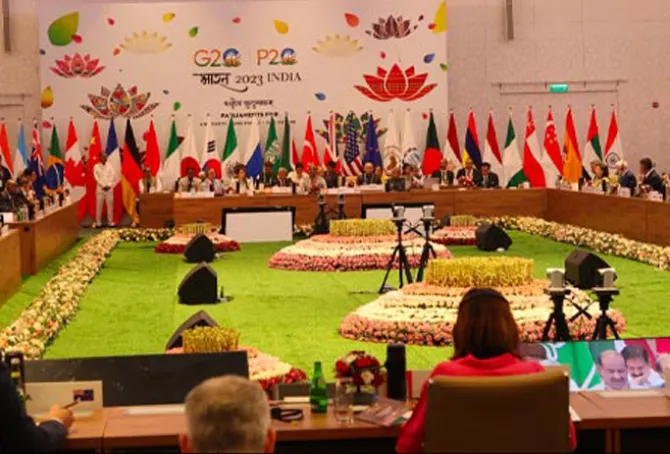-
CENTRES
Progammes & Centres
Location
Since P20-type parliamentary diplomacy has seen acceptance, slight organisational changes can place the P20 on track for being an exemplar multilateral democratic arrangement.

The ninth G20 Parliamentary Speakers’ Summit (P20), hosted by the Parliament of India in partnership with the Inter-Parliamentary Union (IPU), reached a successful conclusion on 14 October 2023. As the parliamentary dimension of the G20, the P20 was attended by the Presiding Officers of Parliaments of the G20 nations. The Speaker of the Lok Sabha, Om Birla, also undertook several bilateral talks on the sidelines of this summit. Unlike other diplomatic summits where the executive heads of state engage in dialogue, the P20 summit directly engages the parliamentarians in multilateral diplomacy. Democratically-elected parliaments, across the world, are seen as embodiments of the people’s will. At a juncture where traditional multilateral governance structures are facing demands for reformation due to a crisis of democratic legitimacy, the direct involvement of national parliamentarians in international diplomacy offers a potential route to infuse democracy into the global governance architecture.
Unlike other diplomatic summits where the executive heads of states engage in dialogue, the P20 summit directly engages the parliamentarians in multilateral diplomacy.
Parliamentary diplomacy can be understood in two ways. First, diplomacy is conducted within the parliamentary organs of international organisations. Diplomatic negotiations that are undertaken to garner consensus within the United Nations (UN) General Assembly can be seen as parliamentary diplomacy. A divergent viewpoint shifts the focus from diplomats and reads the direct involvement of national parliamentarians in international affairs as parliamentary diplomacy. The P20 Summit fits such an understanding where national parliamentarians become a part of the G20 process. Akin to the G20, the P20 is an informal institution and does not have a permanent headquarters or staff. This classifies the P20 as an International Parliamentary Association (IPA). The association-type setup of the P20 is in contrast to the institutional-organ-type setup that can be seen in parliamentary platforms that are a part of some multilateral intergovernmental organisations, e.g. the European Parliament. Since the P20 operates as an IPA, its statements and decisions do not hold a binding statutory force like those of the national parliaments that send their representatives to this summit. The rationale behind the P20 process goes much deeper than this legal debate of binding versus non-binding.
Catapulting national parliamentary representatives into international diplomacy is one of the clearest acknowledgements that global issues percolate into local constituencies as well. Problems like climate change, poverty, and gender inequality are transboundary and affect local parliamentary constituencies as well. Involvement of the parliamentarians from these constituencies into the broader dialogue infuses democratic representation of those who are affected by these issues, directly in the dialogue process. The P20 started in 2010 with this intention, yet its scope was not as broad as it is today. Since 2016, the G20 has enlarged its ambit from being an economic forum and engages directly with issues relating to climate change and sustainable development. This expansion in scope has also been reflected in the P20 Summit. The Joint Statements from all the P20 summits since 2017 have shown an enlargement of ambit concurrent to that of the G20.
Despite an enlarged ambit, the effects of the parliamentary diplomacy of the P20 cannot be overstated. An issue with the association-type built of the P20 is that its meetings were not regular until 2017. Since 2010, the G20 has met 13 times while the P20 has met only eight times. Even when the P20 meets, the placement of the summit vis-á-vis the G20 summit is not consistent. For instance, the P20 held in 2022 preceded the G20 summit whereas the Delhi P20 is a follow-up to the main G20 summit. This represents that the P20 summit operates within an institutional design where it is not placed as a chamber of parliamentary deliberation that sends feedback to the executive heads of state. While this present institutional design has its limitations, it facilitates an array of bilaterals that happen on the sidelines of the P20 that allow the parliamentarians to directly engage in diplomacy.
The P20 held in 2022 preceded the G20 summit whereas the Delhi P20 is a follow-up to the main G20 summit.
It must be noted that such inter-parliamentary diplomacy is not seen at the UN General Assembly, since it is not a body of elected representatives. To address the dearth of parliamentary representation at the UN, the European Parliament recommended a UN Parliamentary Assembly where representatives were to be directly elected by member states. Although this idea of a new parliamentary organ has substantial academic merit, its realisation appears utopian considering that the UN has been rigid towards existing demands for organisational reform. When looked at from this perspective, the P20 summit presents itself as a fertile parliamentary platform, which holds the capacity to infuse democratic legitimacy into the multilateral setup run by executives.
The Campaign for the Creation of a United Nations Parliamentary Assembly had put out a three-stage gradual plan as a feasible roadmap towards establishing a UN Parliamentary Assembly. In the first stage, the Parliamentary Assembly will operate only as a consultative body without any backing from a treaty. At this stage, the body is proposed to support the work of the already existing General Assembly. Gradually, this body shall gain formal induction as a primary organ of the UN. While the UN Parliament project has not yet begun, the P20 is already placed within the premise of this first stage as it supports multilateralism around the G20 process by adding parliamentary representation from national legislatures.
Bringing changes to the existing design of the P20 is easier than realising change within a bureaucratic UN.
Adding weight to P20’s representativeness is the inclusion of the African Union into the G20, making the grouping represent more than two-thirds of the global population. Furthermore, the association-type setup of the P20 also adds to the prospects of this platform as it leaves enough policy legroom with the G20 leadership since there is no legal instrument that needs to be amended to give the P20 summitry a broader role. Thus, bringing changes to the existing design of the P20 is easier than realising change within a bureaucratic UN. One of the first steps in this direction can be fixing the placement of the P20 summit, either as a preceding consultative exercise to the main G20 summit or as a parliamentary discussion done post the G20. Settling this before-after confusion can help to clarify the consultative relation between the executive-led G20 and the parliamentary participation at the P20. Another basic step is prioritising the annual continuity of the P20. Since this track of parliamentary diplomacy has already seen acceptance that is visible through wide participation, slight organisational changes hold promise to place the P20 on track to being an exemplar of multilateral democratic arrangement.
Angad Singh Brar is a Research Assistant at the Observer Research Foundation.
The views expressed above belong to the author(s). ORF research and analyses now available on Telegram! Click here to access our curated content — blogs, longforms and interviews.

Angad Singh Brar was a Research Assistant at Observer Research Foundation, New Delhi. His research focuses on issues of global governance, multilateralism, India’s engagement of ...
Read More +